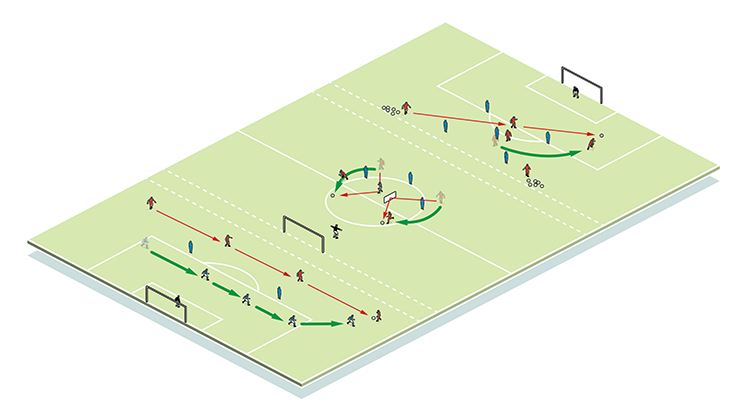




OUR BEST EVER OFFER - SAVE £100/$100
JOIN THE WORLD'S LEADING PROFESSIONAL DEVELOPMENT PROGRAMME
- 12 months membership of Elite Soccer
- Print copy of Elite Player & Coach Development
- Print copy of The Training Ground
You are viewing 1 of your 1 free articles
Maximising the potential of individual, group and team learning
This is a session that lasts 70 minutes, with coaches and players in a number of specialisms – each offering simplicity and structure, yet requiring good technical ability, intelligence and a certain amount of individualism and flair.
| Area | Up to full pitch |
| Equipment | Balls, cones, goals, hurdles, mannequins |
| No. of Players | Up to 20 (11v9) |
| Session Time | Warm-up 15mins, Speed conditioning 5mins, Possession – the lay-off 12mins, Individual and group specifics 20mins, Small-sided game 18mins |
This is a session that lasts 70 minutes, with coaches and players in a number of specialisms – each offering simplicity and structure, yet requiring good technical ability, intelligence and a certain amount of individualism and flair.
We want to construct training exercises that progress from one area to the next, building in difficulty as it goes. This eliminates boredom, keeps players focused, and ensures that each stage of the learning process is realistic and valuable.
We split our coaching team up so that players each have someone overseeing their exercise. This also enables us to coach the whole squad by creating numerous areas where drills, practices and games are performed at the same time.
What do I get the players to do?
Warm-up
We set up as shown (1), with four 15x5-yard channels. At the bottom of each are three small hurdles. At mid-tempo, players have different instructions for running either around or over them, then move to the top of the practice area and back. As one player returns, the next leaves.
1

2. Next, short sprints are made as players continue to work in relay form
Speed conditioning
Next, players must sprint from the start line, run 5 yards to the cone, before coming back.
Possession – the lay-off
This is 9x9 plus two neutrals (2), who play for the team in possession. In the first phase, any attacker can meet a team mate’s pass in one of the two scoring boxes. Receiving an immediate return pass earns him a point.
In the first progression, now only neutral players can venture into the box. Again, an immediate return pass earns a point.
Finally, only neutral players constructing a one-two can earn a point.
2

Individual and group specifics
Now split coaching comes to the fore, with first-team coaches assigned different exercises and tasks.
Defenders and holding midfielders work with myself, Brendan Rodgers, passing the ball from side to side, as shown, and gradually advancing up the pitch (3). They are pressed by a line of four opponents, but must move forward in balance.
3

Wingers and attacking midfielders work with Colin Pascoe, setting up as shown (4) to construct technical link-up play before going through on goal. There is no set structure when looking at the imagination and creativity of our attacking play; but quick and accurate passes into feet and into space will give us the confidence to move around and through opponents.
4

2. Colin Pascoe- Improve Link-up and Combinations in and Around the Box
3. Mike Marsh- Develop Movement in Front of and Behind the Back Four
Finally, attacking midfielders and strikers work with Mike Marsh. This is about penetrating the defensive line, with attackers using clever and sharp passes, blind side and disguised runs.
Small-sided game (5)
We conclude with a game, which is 10v9/9v10 in a 50x40-yard area. We look to develop flexibility, and the confidence for players to put everything they have learnt into a real game situation.
5

Related Files
Editor's Picks
Attacking transitions
Deep runs in the final third
Using the goalkeeper in build-up play
Intensive boxes drill with goals
Penetrating the final third
Creating and finishing
My philosophy
Pressing initiation
Compact team movement
Coaches' Testimonials

Alan Pardew

Arsène Wenger

Brendan Rodgers

Carlos Carvalhal

José Mourinho

Jürgen Klopp

Pep Guardiola

Roy Hodgson

Sir Alex Ferguson

Steven Gerrard
Coaches' Testimonials

Gerald Kearney, Downtown Las Vegas Soccer Club

Paul Butler, Florida, USA

Rick Shields, Springboro, USA

Tony Green, Pierrefonds Titans, Quebec, Canada
Join the world's leading coaches and managers and discover for yourself one of the best kept secrets in coaching. No other training tool on the planet is written or read by the calibre of names you’ll find in Elite Soccer.
In a recent survey 92% of subscribers said Elite Soccer makes them more confident, 89% said it makes them a more effective coach and 91% said it makes them more inspired.
Get Monthly Inspiration
All the latest techniques and approaches
Since 2010 Elite Soccer has given subscribers exclusive insight into the training ground practices of the world’s best coaches. Published in partnership with the League Managers Association we have unparalleled access to the leading lights in the English leagues, as well as a host of international managers.
Elite Soccer exclusively features sessions written by the coaches themselves. There are no observed sessions and no sessions “in the style of”, just first-hand advice delivered direct to you from the coach.







